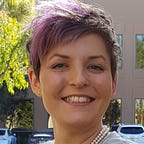Case Study: Problem Solving Steps
An App for the Natural History Museum of Los Angeles
When an amateur is given a problem, he starts brainstorming solutions. Something great has to come out of that smattering of ideas, doesn’t it?
My best project results have always been when my audience brings me to a series of solutions, and by iterating on those solutions I uncover my best ideas.
Solving a problem in the service industry
After building upon our understanding of our user and recognizing themes, opportunity areas, and answering the “how might we” question: Ta-dah! First diamond of the double diamond design theory:
My designer friends and I were just messing around one evening. What if we could build any solution we wanted for any problem in any industry?
“Let’s tackle the aging and technologically-lacking Mineral Exhibit at the Natural History Museum of Los Angeles,” we said.
Research, Empathy, Insights
There is a reason design school teaches you about user personas. When you’ve built a user, you can revisit your materials if you get stuck or need a refresher of your goals. The result of these exercises is you should be deep in her pain. I’m so uncomfortable with her pain-points that I need to find her solutions. I am compelled to fix this for her!
So…
Before we went to the museum on a random Saturday, we built our proto-persona: the rough sketch of a person we believed we were designing for. Then it was off to the museum to interview people who fit this proto-persona.
Upon returning from the museum interviews, we formalized the User Persona above. Meet Megan Wallace. From there, we used an empathy map to get inside Megan’s head. What was she thinking, feeling, saying, doing while in the museum?
Each of the team members took turns writing an Insight Statement based on Megan’s experiences. We filled in who Megan was, what was her need, and what insight could we glean from this need. Our particular process involved each writing an insight statement, then passing to the next person to iterate on each other’s ideas.
Themes
We knew what Megan was thinking, feeling, saying, doing during her trip to the Mineral Exhibit. We next wanted to know the details of when Megan felt those things. Where were the biggest pain points occurring? That might show us where we can make the biggest impact in her journey.
This journey (the bright yellow line) walked Megan through her experience in the museum. We added smiles vs frowns for good experiences vs bad experiences. Then we took a second pass with orange sticky notes to insert potential changes to her experience:
What if purchasing tickets was done ahead of time? On an app?
How could we promote that?
What if there was a welcome app/map/other way to ask where to start?
What if we could adapt an app to each person’s browsing style?
What if we could learn what catches users’s attention by what they capture?
What if we gamified the museum experience?
Could the users share their experiences socially and promote us?
We then took a third pass with potential risks to our proposed ideas (in pink sticky notes). These risks help us understand what’s reasonable and what’s just brainstorming craziness.
Lastly, we took a final pass with blue sticky notes to see how easily mitigated those risks were. (I can’t help it: I’m a project manager by trade — risks are my business).
“How Might We”
This activity led us to narrowing our potential solutions. This was the “How Might We” activity that helped us solve our user’s biggest frustrations. The app was going to create unlimited interaction points for all items in the exhibits. This would educate the user and engage the user in “collecting” items throughout the museum. At the end of the experience, the user could have a collection of what they saw to share with others and promote their amazing experience at the Natural History museum.
From there it was off to Paper Prototype, User Test, and my buddy Mat built these prototype images in Illustrator and then transferred the flow into InVision.
You can tell this is playing around because my one of quirky additions to the app I called “delights.” For example, when a user snaps a photo of a trash can because the user is being cheeky, the app tells them they found “a rare artifact” and tells the user about the NHMLA’s recycling program.
I brought the “app” in InVision back to the Natural History Museum to test it with unsuspecting, potential users. These people gave us additional feedback we could have incorporated into the app before we took our final product to the stages of coding and finalizing the product.
